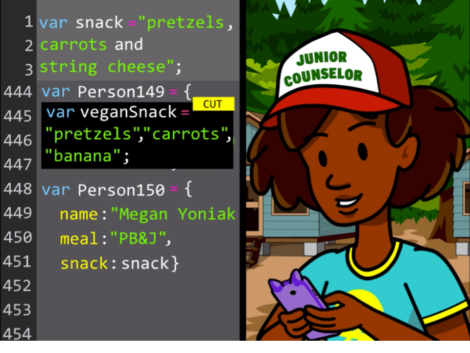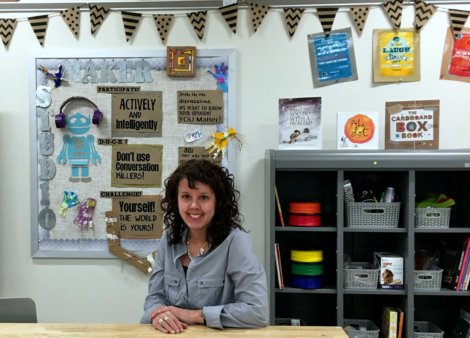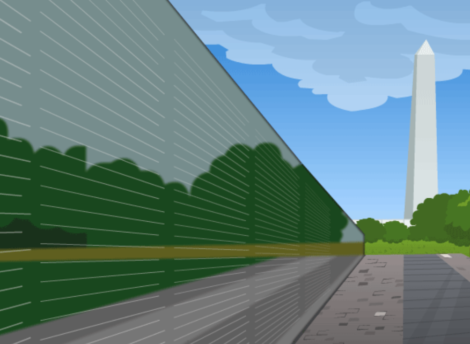
Coding Across the Curriculum
Posted by cemignano on
We’re excited to welcome Certified BrainPOP Educator, Lauren Johnson, back to the blog! Read on to learn about how Lauren was thrown into coding, her fears of the new curriculum, and how it’s come to be something she loves to teach. She even includes ideas for how you can integrate coding into your own curriculum!
<storytime!>
Two summers ago, I was sitting in my principal’s office discussing our new enrichment electives. It had been decided that our 6th and 7th grade students would be given the opportunity to select their enrichment electives. As teachers, we know that choice is a motivating factor for our students, and this naturally sounded like a good idea. That is, until my principal spoke these words:
“Along with Computer, we are also going to have you teach Coding.”
I blinked a couple of times, put on a smile as I thought of the cute and sweet CodeMonkey I had introduced my students to, and concluded my conversation. While I appreciated the vote of confidence that my principal had in me and my abilities, it wasn’t until I got home that the realization hit me. These were sadly the exact words that ran through my head:
“I’m too stupid to teach Coding.”
I’ll be honest, I cried for about thirty minutes as the apprehension of the upcoming year swirled in my head. Yes, I had used Code.org and CodeMonkey, two awesome coding resources, with my students as a way to introduce coding. I knew the basics, but to teach a class solely about coding? I took a deep breath, wiped my tears, and opened my laptop. Putting the negative thoughts behind me, I did some research and began to teach myself code from Khan Academy.
<importantNote>
BrainPOP’s Creative Coding had not yet been created at the time I was learning code. If it had been available, I would have felt more confident in my initial journey. Y’all are so lucky to have this resource available to you!
</importantNote>
At the start of the year, I was honest with my students and told them that I was learning to code with them. After a couple of months, I along with my students were starting to get the hang of it and began to feel more comfortable with the concepts of computer programming. Loops, If Statements, and Functions transformed from terms of terror into everyday vernacular.
</storytime!>
You have most likely heard about code and the possibility of implementing it into your curriculum. While the task seems daunting to many teachers, BrainPOP has created a resource to help make the transition as smooth and seamless as possible. If Creative Coding existed when I first started teaching coding, my experience would be a completely different story. But first, let’s explore a question many teachers ask when first introduced to the topic.
Why code?
Traditionally, we hear the answer, “Why not?” without any further explanation. This traditional philosophical answer does not work well for teachers with already busy schedules. While many schools seem to be diving into coding, there is rarely a genuine answer given as to how coding can help our students grow and learn. Let’s see if I can better answer that question for you.
With the increasing technology introduced in today’s world, coding is a 21st century skill that which our students will learn to become thinkers and problem solvers. Coding teaches our students computational thinking, or 21st century critical skills, that can be used no matter the situation. Through the process of coding, our students learn to identify a problem and try to solve that problem by looking at the big picture and breaking it down into smaller parts. These critical skills, which can easily be applied to all aspects of life, are naturally embedded into the process of learning to code.
<sideNote>
If you would like to learn more about Computational Thinking, be sure to check out this video!
</sideNote>
Before I began teaching Computer, I taught 4th grade English Language Arts and Social Studies. What I would have given to have the BrainPOP tools and resources during those years! As an English teacher, we are very familiar with the writing process as we stress it on a daily basis. While it may seem difficult to find the commonalities between English Language Arts and Coding on the surface, they are more alike than you may think. Believe it or not, the writing process is the same as the coding process!
Let’s first begin by looking at what we as teachers are familiar with, the writing process.
First, we begin the WRITING process by brainstorming. When we are asked to WRITE, we begin by asking ourselves, “What do I want to WRITE?” Next, we put together our ideas as we WRITE the rough draft. Our WRITING takes shape as we work to complete the rough drafts. Then, we begin the revision and editing process. We ask ourselves, “What can I change to make my WRITING better and more efficient? Once those changes are made and we are happy with the final product, we proudly publish our work for the world to see.
Now let’s look at that paragraph again, but let’s change the words WRITE to CODE.
First, we begin the CODING process by brainstorming. When we are asked to CODE, we begin by asking ourselves, “What do I want to CODE?” Next, we put together our ideas as we CODE the rough draft. Our CODING takes shape as we work to complete the rough drafts. Then, we begin the revision and editing process. We ask ourselves, “What can I change to make my CODING better and more efficient? Once those changes are made and we are happy with the final product, we proudly publish our work for the world to see.
<sideNote>
“Even though most people don’t grow up to become professional journalists or novelists, it’s important for everyone to learn to write… Most people won’t grow up to become professional programmers or computer scientists, but developing fluency with coding is valuable for everyone.” -Mitch Resnick (source)
Mitch Resnick is the co-creator or Scratch, a website in which students learn to code and share their projects with other users. He also wrote a book entitled Lifelong Kindergarten in which he discusses the reason so many of us loved Kindergarten. Without realizing it, you learn while you play. He creatively combines the terms into one known as “plearn” to emphasize the importance of play as a means to learn. As users in Scratch play with their code to enhance their programs, they also learn not just coding, but persistence, patience, grit, and problem solving.
</sideNote>
As teachers, we understand the importance of teaching all of our students to write regardless of their career path. While not all of our students will choose computer science and coding as their career path, it is an essential skill to instill in our students. We are almost twenty years into the 21st century. Imagine how technology will evolve 30, 40, even 50 years into the 21st century! As teachers, we are always working to prepare our students for their futures. Their futures will inevitably take place throughout the technology evolving 21st century. How will your students be prepared and ready for their future?
Have I convinced you of the importance of teaching coding? Now let’s discuss how to implement coding into your curriculum!
You’re here because you obviously love BrainPOP. Who doesn’t love BrainPOP and its characters? Whether you use BrainPOP, BrainPOP Jr., or BrainPOP ELL, the characters are relatable and lovable. BrainPOP tools and resources are all about allowing our students to create and show the world what they know.
If you teach English/Language Arts:
- Your students can summarize a story or novel studied in class. This will allow your students to show what they know as they use the BrainPOP characters to recreate the important aspects and lessons learned throughout the story.
- Are you in the middle of a novel? Use this printable to help your students predict what will happen. You can then have your students create their predictions in code! Imagine how fun it will be to see all of the various predictions!
- You can also have your students create a story or even a comic. Stories and comics include a lot of elements including characters, plot, theme, author’s purpose, etc. You can use this printable to help your students plan their stories. Your students will enjoy writing their own creative stories involving their favorite characters!
If you teach Math:
- Your students can code the BrainPOP characters to explain a math concept and the numerous ways to solve the concept similar to a BrainPOP movie. No matter the concept, your students can code the characters as a way to show what they know!
- Your students can create word problems using their favorite characters. For example, Annie needs to go shopping for Tim’s birthday present. She saved $30 of her allowance to spend on his present. Annie found Tim a new t-shirt that costs $13.65. She also found a pair of sunglasses on sale for $11.98. How much money will Annie spend on Tim’s present? How much change will she receive in return? Of course, Moby has to try on everything in the store! You can share the codes with your students as they work to solve each other’s word problems presented in a new and fun manner!
- Your students can create a “pun”ny meme involving a math concept. Did you hear about how 7 was over the drama? He just couldn’t even!
If you teach Science:
- Your students can code the BrainPOP characters to conduct a science experiment. After conducting a real life science experiment using this printable, students can recreate their experience through code. Don’t forget about Science safety! How funny would it be to see our mischievous Moby demonstrating the wrong way to do things!
- Wondering if your students are grasping a particular topic? Your students can code the characters to explain and demonstrate the concept similar to creating their own BrainPOP movie!
- Your students can create a newscast depicting natural disasters including the casue and effect upon the population and culture of a particular area.
If you teach Social Studies:
- Have your students create a museum. You can use this printable as a way for your students to brainstorm and plan their museum. Any topic will work for creating a museum exhibiting historical figures, places, and artifacts. Your students can also code their favorite BrainPOP characters to act as tour guides describing each aspect of their museum and its impact on history.
- Have your students code a scene recreating a significant historical event utilizing the BrainPOP characters. Your students can depict its significance and the effects the event had on history.
- Have your students create a newscast describing a historical moment in real time and how the event will impact history.
- Have your students code a demonstration a key concept in Social Studies. Studying supply and demand? Your students can code a scene in which Moby demands a product and Tim and Annie must figure out a way to supply it!
Check out these awesome examples of coding projects!
While this sounds great, you’re probably now wondering how to get started. My advice is to begin with one of the block based coding projects. Based on Scratch, the initial tutorial walks teachers and students how to use the blocks to code the characters, or sprites as they are called in Creative Coding. Connect the blocks as you wish and see what fun actions you can have the characters do! Now you’re coding!
Once you and your students are comfortable with the block based coding, you can try Creative Coding’s text based coding, Vidcode. Using Vidcode, you and your students will type code based on JavaScript just like computer programmers. While this may seem intimidating at first, the initial tutorial walks you through the process of learning to write code. Be patient and follow the steps. With time, you and your students will feel inspired as you see your lines of code become a product you are proud to share!
In a world where our students crave instant gratification, learning to code is the remedy. Coding teaches patience and persistence, two skills that are also hard for adults to master! As you move forward in your coding journey, remember to plearn and enjoy the process. Grab your coffee or tea, take a deep breath, and don’t be afraid to make mistakes and fail forward. With patience and persistence, I promise you’ll get there. If you shed a tear or two, just remember that we all start somewhere. And never forget, it is ok to ask for help.














